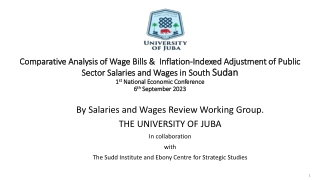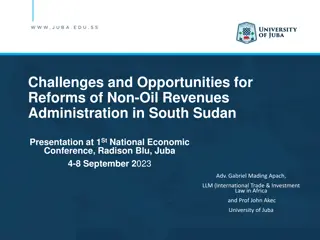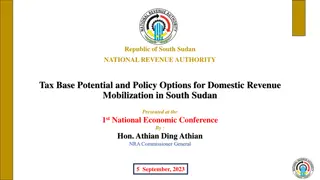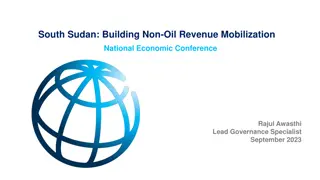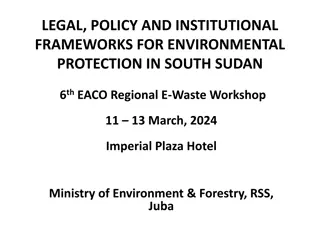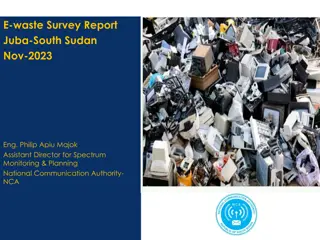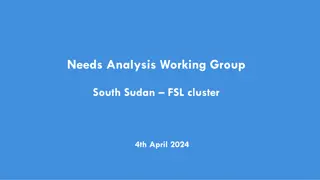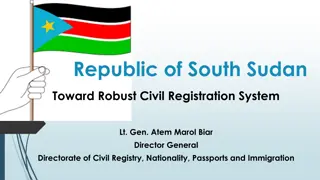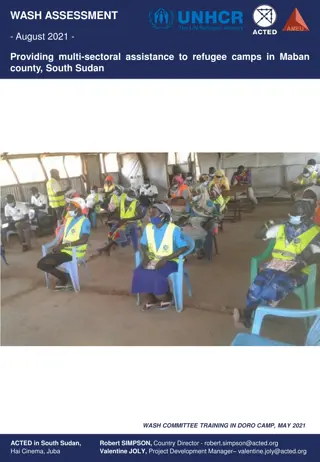
Impact of COVID-19 on Taxpayers: Support Measures & Deadlines Extension
The COVID-19 pandemic has led to global economic challenges, prompting tax administrations to offer support through measures like deadline extensions. Learn about the impact on taxpayers and the extension of tax deadlines due to the pandemic.
Download Presentation

Please find below an Image/Link to download the presentation.
The content on the website is provided AS IS for your information and personal use only. It may not be sold, licensed, or shared on other websites without obtaining consent from the author. If you encounter any issues during the download, it is possible that the publisher has removed the file from their server.
You are allowed to download the files provided on this website for personal or commercial use, subject to the condition that they are used lawfully. All files are the property of their respective owners.
The content on the website is provided AS IS for your information and personal use only. It may not be sold, licensed, or shared on other websites without obtaining consent from the author.
E N D
Presentation Transcript
Overview : Following the declaration of COVID -19 as a global pandemic and the intensification of measures intended to contain the spread of the infection, the adverse impact on the economy is already being felt. It is expected that the economic downturn will be worse than anything witnessed in recent times, including the global financial crisis in 2008. The pandemic has disrupted lives across all countries and communities and negatively affected global economic growth in 2020 beyond anything experienced in nearly a century.
Estimates indicate the virus reduced global economic growth in 2020 to an annualized rate of around -3.2%, with a recovery of 5.9% projected for 2021. Global trade is estimated to have fallen by 5.3% in 2020, but is projected to grow by 8.0% in 2021. Among these actions are measures being taken by tax administrations to ease the burdens on taxpayers and to support businesses and individuals with cash flow problems, with difficulties in meeting tax reporting or payment obligations or otherwise facing hardship.
So in this short presentation we are going to see covid-19 impact on : A. Measures Taken to Support Taxpayers . B. Digital Resilience in the COVID-19 Environment .
First : Measures Taken to Support Taxpayers In order to spread light on procedures in Sudan we are going to look at one of the supporting measures to taxpayers in in brief details: * Regarding additional time for dealing with the pandemic we will talk on the following actions:
1/ Extension of deadlines In many countries, the COVID-19 outbreak falls within the period in which income tax return filing and payments are due. In addition, many taxpayers have to regularly file and pay employer withholding taxes (e.g. PAYE) and VAT or sales taxes. These deadlines could be pushed out by several weeks or months, to provide individuals and businesses impacted by COVID-19 with additional time to file their tax returns and related forms as well as to make tax payments. This could either be automatic or on request in a simplified format (e.g. email, phone) .
This may be particularly important where taxpayers require the assistance of intermediaries or specialized staff and systems to file returns. Remote working may make this impossible for some taxpayers, for example for system security and access reasons, and key staff may not always be available due to illness or caring responsibilities. At the same time, there may be situations where tax return information is used to provide other government benefits. In such a scenario, the tax administration may consider retaining the return filing deadline (possibly except for specific cases) while extending the payment deadlines, or to allow the previous years tax return information to be used in these cases.
This would allow the processing of benefit payments and provide taxpayers with additional liquidity Further, the tax return information could be used to better understand the economic impact of COVID-19, to identify which sectors require additional assistance and to see when the economy is starting to recover. As in the Sudan the submission for financial statements has been extended. For all taxpayers, the balance sheet and its annexes, can be submitted by 30th of May instead of 15th of April, but for tax returns submission has been extended to May 30th instead of April 30th.
2/ Deferral of payments The COVID-19 outbreak has an unprecedented impact on the cash-flow situation of many individuals, who may for example be laid-off temporarily from employment or who have to take unpaid leave for caring responsibilities. For many businesses, particularly small businesses and the self-employed, the down-turn in economic activity will also have severe consequences as shops are being closed, the number of customers may be reducing significantly, contracts may be terminated, supply chains interrupted, etc .
At the same time those businesses continue to have regular expenses such as rental of business space, utility bills, wage costs and so on. Cash-flow issues can cause the failure not only of one business but also of connected businesses through a domino effect. Tax administrations could consider assisting taxpayers and easing cash-flow burdens by deferring tax payments which are due in instalments (for example quarterly or six monthly) or by downward adjustments to advance tax payments (or even suspension of such payments) even where profits are expected for the fiscal year. In the Sudan Payments due on or after 15 April can be deferred by up to 4 months. This includes payments associated with business activity statements, income tax assessments, fringe benefit tax assessments and excise. No substantiation is required.
3/ Remitting penalties and interest Tax administrations Typically apply penalties for late filing of tax returns or for late tax payments. In addition, interest may accrue on late payments. Such penalties or interest payments can both cause cash-flow problems as well as potentially cause significant stress for some taxpayers at the current time, particularly if there are difficulties in communicating with the administration on these issues or in exercising appeal rights. Tax administrations may wish to consider where it may be appropriate to suspend penalties or interest, particularly where extensions of deadlines are granted. Consideration could also be given to the case of penalties and interest decisions which have been issued but which are not yet paid, for example where it could be presumed or demonstrated that there is a link with COVID-19. Regarding Sudan administration ,for all declarations and payments where deadlines have been extended the application of penalties and interests is suspended until the expiry of the new deadlines and beside that circumstances of the company is always taken into consideration.
4/ Easier access to debt payment plans and extension of plan durations Taxpayers who owe tax debt often have the option of entering debt payment plans, though this may be with some conditions for entry into those plans (such as not in arrears from a previous debt plan). In some administrations applications for debt payment plans can be made through an automatic process whereas in other cases discussions with the administration may be a pre-condition. An option for tax administrations to consider where appropriate could be to give easier access to both payment plans and to extensions of plan durations, particularly where there is a risk of hardship or significant cash-flow concerns. Consideration may also be given to having an interest free period. In Sudan the deadline to request debt payment plans was extended until 30 June 2020. Further, payment plans which would have ended before 30 June 2020 have been extended until that date.
5/ Suspending debt recovery Administrations may want to consider suspension of debt recovery, including suspending the garnishing of wages or bank accounts and asset seizures and sales. These can have severe impacts on some taxpayers in current circumstances. This may be an area where tax administrations want to consider reviewing the guidance for case-by-case decisions in the current environment. Consideration also needs to be given, though, to the impact of a significant build-up of debt which may increase the problems facing taxpayers over time and may increase the likelihood of default. Debt recovery has been suspended or postponed in STC but not to exceed 31th of Dec 2020.
6/ Quicker refunds Quicker refunds where taxpayers are owed money, processes for refunds might be prioritized to ensure that money is paid out quickly, particularly where the amounts involved may have significant impacts on cash-flow either because of the amounts involved or the nature of the taxpayer. In addition to quicker processing (which may not always be possible given tax administration staffing constraints), tax administrations may wish to consider relaxing the risk checks done before making some refunds, for example below certain thresholds or in the case of taxpayers with good compliance histories, while being cognizant of fraud risks. While this may require taxpayers to file returns, particularly in the area of VAT, this is not contrary to supporting taxpayers by extending filing deadlines. In our administration All applications are being prioritized for approval under the legal obligations and deadlines. There is coordination with the Ministry of Finance and Economy to prioritize through the Treasury.
7/ Audit policies and tax certainty Audits can be a highly resource intensive process for taxpayers as well as tax administrations and divert them from other issues that they are confronting at the current time. Physical audits can also involve transmission risks for tax administration staff and taxpayers. Consideration could be given to a temporary change in auditing policy, particularly for taxpayers for whom audits involve a proportionately greater diversion of resources and time. This may be done through the adoption of a blanket policy or through changes in risk parameters. In making changes, though, tax administrations will want to look carefully at larger risks, in particular risks of fraud, for example frauds involving employee funds or pension contributions. Consideration could also be given to where it may be possible to give early tax certainty to taxpayers about their tax liabilities where that may unlock cash-flow or release resources.
There may also be a cross-border element to this, in particular for smaller firms which can be impacted more substantially than larger firms by concerns about the possible impacts double taxation on cash-flow. All audits in STC currently in progress which require the physical presence of the audit inspector in the taxpayers premises are suspended until the situation is normalized. All planned audits where the taxpayer has not been / or has been notified of the start of the audit, will also be suspended.
8/ Enhanced services and communication initiatives Many tax administrations have expanded their digital communication channels over recent years, from great digital interaction with the tax administration to direct digital messaging, the use of web chat, social media, mobile applications etc. The increased use of such services, including through efforts to shift taxpayers to these channels, may help in reducing physical contacts (for example through tax offices) and help get speedier responses to taxpayers. To deal with the particular issues raised by COVID-19, administration may wish to consider putting in place dedicated web pages, media strategies, hotlines (possibly with call-back facilities), changes to mobile applications, the updating of virtual assistants etc. as well as considering how they might get messages out through intermediaries.
Tax administrations may also want to undertake analysis of the different concerns expressed by taxpayers which can feedback into consideration of where additional measures (administration or policy) might be useful. It will also be important to carefully monitor issues with particular services (such as long wait times on telephone lines) and to consider the development of additional messaging (such as FAQs) and, where possible, changes to the times that services are available. Tax administration may also wish to consider whether some staff can be redeployed to assist where there are very high demands on a particular service. Tax administrations may also wish to consider how the measures that they are taking can be best communicated to digitally disadvantaged taxpayers and how they can be most easily taken up, for example through use of the telephone, fax machines, post or through communication by family members etc. STC tax administration also recommended taxpayers to use remote services to comply with tax obligations. As telephone ,sms and emails.
Second / Covid-19 and digital resilience Figures concerns (Large Taxpayers Office) LTO The timely and efficient provision of services to taxpayers and other stakeholders is a critical part of tax systems. The provision of information and services can be proactive (e.g. outgoing communication) and reactive (e.g. responding to incoming requests). Over the recent years, many tax administrations have expanded their digital communication channels and service offerings, from digital interaction with the tax administration to direct digital messaging, the use of web chat, social media, mobile applications, etc. However, there remains a large number of taxpayers that continue to make use of non-digital communication and service offerings, such as paper-based inquiries or in-person visits where communication has been much more difficult during the crisis.
Taxpayer services Compliance risk management Remote working Here is an overview on the role of the digitalization of tax administration in dealing with the COVID-19 crisis and we will look at three different areas: Now we can access the different sections of these measures: Measures to support taxpayer services 1/ Taxpayer services The timely and efficient provision of services to taxpayers and other stakeholders is a critical part of tax systems. The provision of information and services can be proactive (e.g. outgoing communication) and reactive (e.g. responding to incoming requests).
Over the recent years, many tax administrations have expanded their digital communication channels and service offerings, from digital interaction with the tax administration to direct digital messaging, the use of web chat, social media, mobile applications, etc. However, there remains a large number of taxpayers that continue to make use of non- digital communication and service offerings, such as paper-based inquiries or in-person visits . Where communication has been much more difficult during the crisis.
Selected Interactions with Taxpayers (STC) Type of interaction Number of interactions Digital assistance Done with three groups. PIT,VAT and BPT Email inquires 140 taxpayers 140 taxpayers Paper based inquiries (e.g. letters) In-person inquiries 140 taxpayers Telephone calls received 100 taxpayers Online inquiries (e.g. application or website) None Source : STC
Paper communication For many tax administrations, dealing with paper-based communication is not a simple task in the COVID-19 environment. Offices might be closed and cannot accept postal mail, or postal mail may be received at office locations that are working with reduced staff numbers. Both may result in significant delays in both opening and processing paper documents. According to the LTO statistics the following figure shows estimates of change in paper communication during the pandemic:
Dealing with paper communication during the crisis change, 40% no change, 60% Source : STC (LTO)
In-person communication With many administrations partially or fully closing their offices, face-to-face meetings with taxpayers and their representatives as well as other in-person communications have been significantly affected. Even where closures are partial, measures are taken to ensure staff and taxpayer safety, for example through social distancing policies, and in-person meetings are generally limited to exceptional cases. 2/Compliance risk management Managing compliance risks in the COVID-19 environment has unsurprisingly proved to be much more challenging. Over the past years an increasing part of compliance activity has been shifted to non-human interventions. This has been made possible through the increasing availability and use of data, the use of data science techniques and automated compliance checks. There is still, though, a significant number of tax officials involved in this process. However, the closure of tax offices and the move to remote working for large numbers of tax officials has significantly affected compliance interventions and how they are conducted.
Field audit work The risk of tax evasion and fraud during the pandemic is highly likely to have increased. This results from a number of factors, including that: the situation is fast-moving; there is great potential for misinformation or confusion; and there may be reduced controls in place. It is therefore important that tax administrations consider additional options, including the use of technology tools, to help ensure compliance and reduce evasion and fraud risks. 3/Remote working : Lockdowns and related measures meant that many administrations moved very rapidly to a remote working environment, with many officials working from home full-time.
For many administrations, going to the office became the exception. However, not every administration was prepared for this sudden move and some had troubles providing staff with the necessary IT equipment or remote access to the internal IT environment. A key indicator when moving to remote working is the percentage of staff that is ready to work remotely if required, i.e. the overall readiness of the administration. It is highly likely that low percentages as regards the overall readiness will cause significant problems when having to move rapidly to a remote working environment. As regards the overall readiness, it was possible to observe extreme differences among administrations ranging from 0% to 55% of staff being ready to work remotely. Beside that tax officials over 50 years old were allowed to stay at home without affecting their wages and incentives, beside those who are fit to work were allowed to work 3 days a week .


